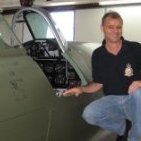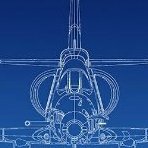All Activity
- Past hour
-
Hmmmm. I know nothing about the kit, how is it? Any decals out there for it?
-
 vvwse4 reacted to a post in a topic:
Westland Wasp HAS 1: 1/24th Scale.
vvwse4 reacted to a post in a topic:
Westland Wasp HAS 1: 1/24th Scale.
-
The Fore Course is bent to its yard and I also ran the Jeers for the yard, below are some photos of that work and a detail shot of the backside of a sail showing how I attached them to the yards. I used a method that is somewhat close to how period ships' sails were bent to a yard. At this scale it is not possible to run lines and tie knots as they actually would have been done as the result would have been very overscale and would not look right as the line knots would have been far to bulky. So I went with simple overhand or square knots, but threaded the line close to how it was actually done. Below is the result. The Fore Course "brailed up" and with the bunt, leech and clew lines under light tension. I like how the sail looks much better then my effort with the Main Course. I am seriously considering redoing the Main Course to get it closer to this look. As the photo below shows there are now a lot of lines. This drove my decision to run the Jeer lines now as that would have been much harder if I waited to do that job once the masts were in place and the shroud and stay lines run and fixed. It was enough of a challenge to run the Jeer lines given how they are located and because I opted to use thread closer to the correct scale size then that called for by the instructions. Being able to tilt the mast as required really helped make this task much easier and I am probably going to rig one end of any other running rigging lines that I think can be done now without making the job of running and fixing the standing rigging problematic before gluing the masts in place. The thickness of the thread I used for the Jeer lines was too thick to tie off and still look decent, so I had to seize the lines to the top of the blocks after threading them through the eye. I could not use the method I have used for all the other seizing work I have done because the blocks are "in situ". After some thought I decided to try simulating seizing by using a series of overhand knots wrapping one end of the then line I used for seizing around the thicker line before tying the overhand knot. It turned out surprisingly well. I am going to revisit the Mainmast to reshape the Main Course and run the Jeer lines after bending the Fore Topsail to its yard. I am getting very close to stepping masts permenently in place and begin running and fixing the standing rigging. Ernest
-
We've moved a fair distance round the sun since the last update, so probably time to shows some signs that this project is still going - in and around the other cares of life! Derek - that's extremely kind of you - thank-you! Thank you sir I think a certain absence of sanity is certainly required - that and not knowing in advance what you've let yourself in for!! Dead decent of you to say that. Thanks. It's my earnest contention that if someone can draw even half-decently with pencil & paper, they can produce this kind of work themselves. It's also great the way these tools can add variety and excitement to this hobby. Seriously Anthony - you don't. You'll just get funny looks when you're out in public like me.... Ta Kev. Thanks Ivan and yes - as you can see below work is still happening. Happy to sell you a kit when things are ready - can you PM me as to which scale you'd like? (It'll be available in 1/24 and 1/32 scales). Thanks Håkan! The short version is the sheer number of CAD components awaiting realization in physical form got somewhat out of hand in that I'd begun to forget what was what, so I sat down and over the last couple of months have been outputting, supporting and test-printing these various parts. I managed to crack the glass on my 3d printer which slowed things down waiting for the replacement glass to arrive and fitting it. Working out what parts - for reasons of fragility and material strength - would need producing in the (much) stronger Hard Tough resin from eSun which you'd seen me use previously (the black stuff), and which would be happy using just Elegoo's 8k Space grey or Standard Grey resins took up most of the time since the last update. The only sure way to work which needed the tougher resin was to print them in standard grey and see which bits (thankfully not that many) failed or were not strong enough to survive handling/assembly. These are the successful results of this process: - and to dispel any notion that over time you get good enough for anything but single parts here and there to print successfully first time, here is a selection from the 'boneyard' of prints which failed either due to inadequate orientation and/or support design, or the standard resin lacking structural strength for very thin regions on a part: I'd shown the design for the rear wall of the cabin on here before but have since revised the design of it in Fusion so that the angled rear-window panels on either side of the central panel integrated are now into the one part: This should make assembly easier in term of keeping them at the correct angle to support the vacformed roof transparencies: All surface details remain present in the 1/32 version below as well; my guesses about minimum feature size in the 1/24 version that will survive scaling down seem to be holding up pretty consistently across the model so far: The doors too are now finalized in physical form, both front: - and rear sets: Similarly, I haven't found any detail absent from the 1/32 versions: One of the door pillars at 1/24.o The lozenge shaped feature is for the naviagation light which will be printed separately using AnyCubic's High Clear resin and tinted: The sliding windows for pilot/obervers had their frames printed using eSun Hard Tough resin as they were too thin for the 8k resin: Again the 1/32 version of these also survived reduction ins scale and printed as well. Amongst a number of other components that turned out to need reproduction using the black eSun resin for strength were the jury struts onto which the floation gear attaches as the front: On the 1/24 version shown here you can see from the translucency down the sides just how thin the edges of that I-beam shape are. The translucency eviudent below also indicated how thin the walls of the recess which the float gear struts fit into are. This necessitated adding a small reinforcing panel inside of there on either side: The 1/32 version worked fine: The walls of the strut recesses were so terribly thin at 1/32 though that I could only have holes for the flotation gear struts themselves to mount into, leaving just a visual suggestion of the shape of the recess itself: The driveshafts from main to reduction gearboxes were also done up in black stuff as they'll aid support and alignment the entire engine/gearbox asssembly when it sits on the egnine deck later on: The rear cabin framing at 1/24: - and at 1/32. Both self-evidently neededthe stronger resin to avoid breakage during kit assembly: I wasn't sure if the door handles (on the right end) would work at 1/24 but they did: More improbably however they also printed at 1/32 using the smallest feasible tree support I could devise in VDT: Using Elegoo's 8k resin, definition of detail on the nose section was extremely rewarding at both 1/32: - and 1/24: The two large holes dead centre aren't obviously present on the actual Wasp but are drain holes added here to avoid suction issues during printing, which had caused print/support failures in early tests. These also coinicide handily however with those traces of striation you can see at the tip of the nose, so both issues can be dealt with in the same operation without the risk of damage to surrounding features. My heavy handling during support removal resulted in some fracturing along the cheek window guttering, though such issues are easy enough repaired with some tape, resin and the UV laser: UThe lower section of the nose showing RADALT enclosures, which agaqin will have their honeycombed glazing printed separately from clear resin: Designs for both Bthe Mk44 & 46 torpedoes were tested in 8k resin: Mk.44 first - this turned out nice and sharp at both scales: I wasn't too concerned about the support structures for that annular feature at the rear on the 1/24 scale: But did find an issue with my supports for the fins not being robust enough at 1/32: This has since been reprinted successfully with the offending supports being made 2 microns thicker. Sometimes all it needs is a little tweak! The propeller assemblies of the Mk.44 at 1/32; I have to say the support design routines in Voxeldance's Tango software have performed outstandingly with everything I've thrown at it on the trickiest of thin features like these: The Mk.46 reproduced equally well at both scales, with no features failing: Part definion on the props for both sets. 1/24 looked nice: 1/32 turned out far less of a problem than I'd feared due to the responsiveness of the support processes in VDT: All the fiddly detail on the carrier racks and sway braces which took so long to do up in CAD had me very happy at the printed results - there were no features missing or compromised at either scale (both sides shown below at 1/24): Details like the suspension bands on the torpedo bodies also turned out nice and sharp using the 8k resin: The landing light assemblies and transponders at both scales: The main fairing sehown here at 1/24: With the same level of detail still present in the 1/32 version: Temptation struck and I couldn't resist dlashing together a 1/32 test print of the Mk.46 torpedothe other night 'just to check' that the parts fitted together successfully: Over last weekend I sat down, went through the existing printed parts inventory and drew up a snag sheet for all the parts still needing to be designed in CAD: The bulk of this as you can see involves the cabin & cockpit interiors, so in preparation for the next phase, here are the reference mosaics I work from ready to start preliminary sketches for those areas: There's a lot inside there to get wrong so I'm curently at work on the drawing board with pencil and paper, sketching out the various features and forms to get a better understanding of the various fittings and how they interact in space. Thanks for reading as always and best wishes for success in your own work. Tony
-
 coogrfan reacted to a post in a topic:
Scratchbuilt 1/24 Grumman F8F-1 Bearcat
coogrfan reacted to a post in a topic:
Scratchbuilt 1/24 Grumman F8F-1 Bearcat
-
Just taking a wild shot here hoping someone knows how to contact support at iModeler about an account reset problem? I've been trying to get my password reset for several months now but the site never actually sends out the reset code (I have checked my junk email). I cannot find any way of contacting the administration for support without being logged in.
-
 coogrfan reacted to a post in a topic:
Kotare Spitfire Mk IIa
coogrfan reacted to a post in a topic:
Kotare Spitfire Mk IIa
-
 Troy Molitor reacted to a post in a topic:
David Union Sanders / now optimum handy Routers
Troy Molitor reacted to a post in a topic:
David Union Sanders / now optimum handy Routers
-
Look great! Without making me dig out my conversion set, how are these decals different? Since I have no idea which plane I will end up building, I would buy the decals now if they are different from the original set.
-
 Pastor John reacted to a post in a topic:
Pastor John….a very happy birthday!
Pastor John reacted to a post in a topic:
Pastor John….a very happy birthday!
-
 Pastor John reacted to a post in a topic:
Pastor John….a very happy birthday!
Pastor John reacted to a post in a topic:
Pastor John….a very happy birthday!
-
 Pastor John reacted to a post in a topic:
Pastor John….a very happy birthday!
Pastor John reacted to a post in a topic:
Pastor John….a very happy birthday!
-
 Pastor John reacted to a post in a topic:
Pastor John….a very happy birthday!
Pastor John reacted to a post in a topic:
Pastor John….a very happy birthday!
-
 Pastor John reacted to a post in a topic:
Pastor John….a very happy birthday!
Pastor John reacted to a post in a topic:
Pastor John….a very happy birthday!
-
 Pastor John reacted to a post in a topic:
Pastor John….a very happy birthday!
Pastor John reacted to a post in a topic:
Pastor John….a very happy birthday!
-
Thanks everyone - much appreciated
-

David Union Sanders / now optimum handy Routers
Bill Cross replied to Troy Molitor's topic in Vendors Board
I am interested in hearing about anything you sell. Period. -
!!!!!!!!!!!!!!!!!!!!!!!!!!!!
-
Si, your work here on LSP is highly appreciated weather the models are finished or not! Most of us here have more unfinished projects going, than completed ones. Just know that whatever you chose to share is a valued contribution. I marvel at the stuff you post and enjoy watching your process. Yeah, this one is fighting you big time. A refreshing break is in order!
- Today
-
Five coats so far ! I'm concidering to cancel this build. It doesn't look right.
-
ulvdemon started following OIF Blackhawk
-
VERY impressive and realistic exhaust stains @spyrosjzmichos. Except one thing: on wartime Jugs, those outlets were not exhausts but the waste gates for the turbo, therefore NO staining whatsoever. On restored planes like the one on your reference pics, they left off the turbo and used the outlets as gas exhaust, hence the extensive staining. Far from being a P-47D expert, I learned this during the building of my first MiniArt 1/48 kit and thought I’d share it with you. Cheers, Quang
- 88 replies
-
Wow.. the weathering on the underside is some of the best I have ever seen. Very impressive work Niels
- 88 replies
-
By far the most complex set was the corrected variramp and accurately sized air intakes! That was a nightmare that took me two months of evenings to get correct and symetrical parts! Never again!!!
-

Scans from Japo Luftwaffer over Czech territory III needed
Mark P replied to LSP_K2's topic in General Discussion
Kevin: E-mails sent with some information. HTH Mark Proulx -

Hawker Hurricane 1/12 scale scratch build
hurribomber replied to hurribomber's topic in Works in Progress
Help! I would like to build the doghouse as true to the original as possible. Unfortunately, I don't have a drawing of the 70° inclined front former 3. I also have no drawings of 3B upper and 3A lower. (red markings) Who can help ?? Cheers Thomas -
Thanks! Harold did the nose. I made the rest!
-
The wiper was part of the conversion. I did it to help Harold.
-
Excellent work!
-
Euro Model Expo 2024 at Lingen/Germany - photos of the large scale planes
dutik replied to dutik's topic in LSP Discussion
My photos are a lot larger. But for one reason or another I am not able to link the images from imgBB in a way to have them expandable to full size. Using the "BB code", full image, not preview, but well, but with results is as shown above. If someone is more familiar with imgBB and has an advice? Regards - dutik -
Euro Model Expo 2024 at Lingen/Germany - photos of the large scale planes
dutik replied to dutik's topic in LSP Discussion
A bit of WW1 aviation: Small scale: Has someone here with a Felixstowe stash the balls to build THIS row in LSP size? And an interwar behemoth. He is just large in it's own way: Enjoy! - duitk -
Here's a link for a tutorial I made a couple of years ago. https://mpminiatures.wordpress.com/2021/06/21/how-i-photograph-scale-models/ If you find that it is not clear in any part of it, please give me that feedback so I can improve it and make it as clear as possible. I hope you find it useful. Cheers
-
Thank you Geedubelyer and Boris! Håkan
-
Hey, that's fun! - Dennis S. Mount Juliet, TN USA







